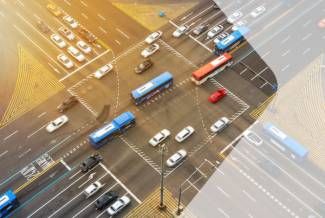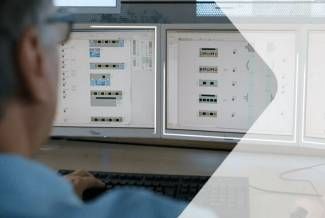Autonomous Driving:
Pros & Cons
Autonomous driving: Pros and cons! Autonomous driving is a term that has been the focus of much attention for some years now and has raised high hopes, especially in terms of road safety. Autonomously operating cars that transport people safely from A to B in road traffic actually bring many improvements. But what are the concrete advantages and disadvantages of autonomous driving? And how far along are car manufacturers in this technology?
This page provides clear answers and tells you everything you need to know about the advantages and disadvantages of fully automated driving.
Definition: Autonomous driving
Autonomous driving aims to make traffic on roads and highways more comfortable and, above all, safer. With the help of technical means such as AI, laser and cameras, vehicles should be able to independently assess traffic situations, recognize obstacles and dangers, and act autonomously. Manufacturers such as BMW, Mercedes and Audi are at the forefront of innovations in this field.
However, what sounds like a technical utopia in which you can sit back comfortably and leave everything to the car until you reach your destination does not yet correspond to reality. For one thing, vehicles are classified into different levels, of which only level 5 is truly autonomous. In addition, there are also political and economic obstacles.
Advantages:
Benefits of autonomous driving
Autonomous driving in itself has both advantages and disadvantages. That's why opinions on the subject vary widely. For example, autonomous driving cars have great potential, but also pose various challenges. Nevertheless, they can fundamentally be seen as progress. This is supported by the numerous economic, ecological, traffic-related and social advantages of autonomous driving, which are examined below.
1. More Safety
Accidents are often caused by driver fatigue, lack of attention or incorrect behavior. This means that almost 99% of all accidents are due to human error. With the elimination of the driver as a source of error and increasing sophistication of systems (sensors, cameras, and AI system), driving can be made more efficient and the accident rate can be reduced. In addition, autonomous vehicles have a lower reaction time and thus shorten braking and starting times.
2. More Time and Comfort
Depending on the level of the autonomous vehicle, drivers can sit back and relax, take short breaks and devote their time to other things. In the best case, with a level 5 vehicle, you are just a passenger, while the means of transport reliably takes you to your destination.
3. More Efficiency in Traffic
Autonomous vehicles are able to communicate and coordinate with each other (Car2x communication). They can thus improve traffic flow and increase road capacity.
This reduces annoying and time-consuming traffic jams, allows shorter routes to be taken, and makes driving more efficient and energy-saving overall. This also offers major advantages in logistics.
Good to know: Test tracks for autonomous driving have also been in place in Germany for some time:
- Digital Test Field Autobahn (2015): A9 in Bavaria
- Two test routes in downtown Hamburg (2019)
- One test track in downtown Berlin (2019).
- Test area at the border triangle of Germany, Luxembourg and France (2019)
4. Accessibility
Autonomous driving can improve accessibility. Even people who may still have to rely on others for mobility today, will have the opportunity to participate in road traffic again in a self-determined manner thanks to autonomous driving.
Economically, this results in another advantage, namely that manufacturers can thus tap into a larger target and customer group.
P
5. Parking Spaces
With autonomous vehicles, fewer parking spaces are needed if the car lets the passenger off and continues on to the next destination. However, if a parking space is still needed, the user is spared the long search for a free space, because the car can independently look for a parking space and then transmit the position data.
Conversely, the vehicle can also move from the parking space to the user – keyword: valet parking.
Good to know: GPS alone is too inaccurate to track and transmit locations of a self-driving car. A combination of GPS & measurement technology, high-resolution maps and sophisticated systems is used instead.
6. Reduced CO2 Emissions
Since vehicles are no longer parked in the city but can independently find a place to wair outside the city, there is more space for green areas within cities. In addition, the efficient driving of the vehicle reduces CO2 emissions.
Technology also plays a role: Environmentally friendly alternatives such as battery-electric, hybrid, or hydrogen-based drives lend themselves to this, as charging and refueling times can be calculated by the system and planned in good time.
Good to know: At SWARCO, we believe that the widespread introduction of alternative drives is necessary in order to be able to achieve agreed climate targets.
7. Reduced Operating Costs
Driverless transportation offers opportunities for cost savings in logistics and the mobility sector. Equipping a vehicle with the necessary systems is more profitable than the labor costs for driving personnel.
The costs saved can be used to open up new areas and expand services. The same applies to freight transport: With autonomous vehicles, delivery processes can take place at low-traffic times, optimizing the last mile, for example.
Disadvantages:
A critical look at autonomous driving
Despite the many benefits of autonomous driving, the technology still faces many challenges and difficulties. For example, autonomous driving brings with it a number of dangers and ethical issues. Safety gaps and political obstacles have also not yet been completely eliminated. The following challenges for autonomous driving, with all their opportunities and risks, should therefore be considered in more detail:
1. Technical Developments
A system participating in road traffic must transmit, evaluate and calculate large amounts of data in real time for accurate predictions. In order to fully comprehend the driving environment with the large number of road users and the many dynamic processes (even in difficult and complex situations), this system must be highly sophisticated – otherwise it cannot reliably plan the driving course in terms of space and time.
A single error in the software can therefore already lead to traffic accidents. Important: A technical system cannot be matured by testing alone, since no test environment that really covers all situations can be realistically generated. The prerequisite is therefore an adaptive system that is capable of detecting and correcting errors.
Good to know: Predictions differ on how long it will take before there are exclusively autonomous cars on the road. Nissan announced the market launch for 2020, which did not materialize. From 2030, according to Tobias Hesse of the German Aerospace Center (DLR), automated trucks could already be the norm.
2. Expensive
Since the implementation of autonomous driving involves many sub-areas that need to be coordinated or aligned, and the technology alone is a very costly factor, initial acquisition costs are likely to be very high.
3. Surveillance
Where software is involved, two problematic aspects are always present: hacker attacks and data protection issues. So, a car that is continuously online – similar to PC and smartphone – provides attack areas for malicious attacks. For example, via:
- Bluetooth
- SD cards
- Interfaces (USB and diagnostic interfaces)
- SIM cards
In general, the collection of personal data (e.g., video and audio recordings inside the vehicle) is necessary for autonomous vehicles. For example, to compensate for system errors or to be able to evaluate critical situations in legal proceedings.
Here, the question then also arises as to who owns these recordings – the manufacturer or owner of the carsharing group or the vehicle occupants? Privacy risks can therefore not be ruled out.
4. Rebound Effects
Since autonomous vehicles are primarily characterized by comfort, it is possible that they will enjoy great popularity and that this will be accompanied by an increase in passenger car traffic. In order to prevent a significant increase in the number of vehicles on the road and thus also ecologically negative effects, the registration of autonomous vehicles must be controlled.
Good to know: In cities, up to 90% of all vehicles can be saved if they are not available for private purchase. Otherwise, according to Kay Axhausen, professor of traffic planning at ETH Zurich, the convenience of automated vehicles is expected to increase use and even increase traffic.
5. Mixed Traffic
Not all vehicles can be replaced at the same time. Moreover, not everyone will want to do so: Many like to drive cars or do not have enough confidence in the technology. It can therefore be assumed that there will be hybrid traffic in the future, where it is not yet entirely clear who has to behave how (e.g. with regard to priority).
Traffic safety issues may have to be directed by means of legal regulations. These may be followed by systems in situations that they themselves can no longer adequately assess. Road markings will also become increasingly important, according to the U.S. Department of Transportation.
Learn more: Road markings for autonomous driving
6. Vehicle Communication
Another challenge is communication between autonomous vehicles. Since they do not communicate visually, the following means of data exchange are essential:
- Car-2-X communication
- Car-2-Car communication
- Communication with mobile devices
- Data exchange with the manufacturer
- Data evaluation of the environment
- Networking with traffic control systems
This results in large volumes of data that have to be transported in real time. The challenge is therefore to develop networks that enable this exchange reliably and comprehensively.
7. Legal Aspects
In the event of an accident in which there was no person at the wheel, the situation must be assessed completely differently under traffic law than before. Traffic law will have to be adapted to the presence of autonomous vehicles on the road. After all, no real person can be prosecuted in the event of a traffic offense caused by an automated vehicle.
Good to know: Although there are still many challenges to overcome, companies and governments around the world are working to find solutions and establish autonomous vehicles on the roads as quickly as possible.
8. Job Loss
What is an advantage for corporations can be a disadvantage for individuals. Where cost savings are made in regard to employees in order to expand automated transport networks, many jobs may be lost – for example, in the transport sector.
Solutions by SWARCO
Other topics related to
autonomous driving
Under the links you will find detailed information on the following specific topics:
Autonomous Driving & Safety
Autonomous Driving & Ethics
Conclusion: Autonomous driving offers advantages and disadvantages
The advantages of autonomous driving are obvious: Increased road safety, reduced driver workload, lower fuel consumption and fewer traffic jams are just a few. Still to be overcome, however, are issues such as:
- technical challenges
- high cost
- lack of a legal framework
- potential job losses in the transportation industry.
In addition, there are concerns about data privacy and ethics in decision making in case of accidents.
Last but not least: In summary, autonomous driving offers more advantages than disadvantages, and many current challenges can probably be solved in the foreseeable future so that it can eventually be deployed across the board.
FAQ
According to the ethics committee of former transport minister Alex Dobrindt, autonomous vehicles are ethically justifiable if they help to reduce traffic accidents. After all, the protection of human life comes first.
Autonomous vehicles can help protect the environment. On the one hand, through more efficient traffic routes and driving methods, which can avoid traffic jams, for example. On the other hand, car-sharing is a possibility where cars are not parked, but drive on to the next need right away.
Due to the high effort required to develop and establish autonomous vehicles, high acquisition costs are to be expected. Google's autonomous prototype, for example, costs €150,000. However, there are also far less expensive manufacturers.

STAY INFORMED
GET OUR NEWSLETTER!
Subscribe to our ITS / Smart Mobility Newsletter
and receive regular updates on trends, developments, solutions and events.





